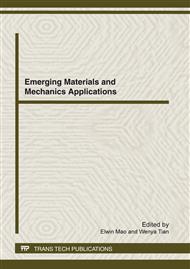[1]
Xu Nanping, Recent developmet of Inorganic membrane, Chemical Industry and Engineering Progress. 4(2000) 5-9.
Google Scholar
[2]
Xu Nanping, Li Weixing, Zhao Yijiang, Theory and method of application oriented ceramic membranes design simulation of relation between membrane permeability and micro-structure, Journal of Chemical Industry and Engineering. 54(2003) 1284-1289.
Google Scholar
[3]
Benito, JM, A Conesa, MA Rodri guez, Preparation of multilayer ceramic systems for deposition of mesoporous membranes, Journal of Materials Science. 40(2005) 6105-6112.
DOI: 10.1007/s10853-005-3172-4
Google Scholar
[4]
Feng Jianghua, Li Huimin, Application of ceramic membranes to the oil removal from the coking residual ammonia water, Industrial Water Treatment. 26(2006) 31-33.
Google Scholar
[5]
Chu L B, Li S P, Filtration capability and operational characteristics of dynamic membrane bioreactor for municipal wastewater treatment, Sep. Purif. Technol. 51(2006) 173-179.
DOI: 10.1016/j.seppur.2006.01.009
Google Scholar
[6]
Wu Y, Huang X, Wen X, Function of dynamic membrane in self-forming dynamic membrane coupled bioreactor, Water Sci. Technol. 51(2005) 107-114.
DOI: 10.2166/wst.2005.0628
Google Scholar
[7]
Zhang Li, The application of inorganic ceramic membrane in wastewater treatment, Industrial Water Treatment. 21(2001) 1-3.
Google Scholar
[8]
Dilaconia C,Lopeza A,Ran adoria R, Conbied chemical and biological degradation of tannery waste water by a periodic subm erged filter, Water Research. 36(2002) 2205-2214.
Google Scholar
[9]
Wang Xin, Huang Ruimin, Chen Kefu, Advances in ammonium removal of tannery wastewater, Leather Chemicals. 21(2004) 9-12.
Google Scholar
[10]
Wang Y H, Zhang Y, Meng G Y, Sol-coated preparation and characterization of macroporous α-Al2O3 membrane support, J Sol-Gel Sci. Technol. 41(2007) 267-275.
DOI: 10.1007/s10971-006-1504-8
Google Scholar
[11]
Biesheuvel P M, Breedveld V, Higler A P, Graded membrane supports produced by centrifugal casting of a slightly polydisperse suspension, Chemical Engineering Science. 56(2001) 3517-3525.
DOI: 10.1016/s0009-2509(01)00037-9
Google Scholar
[12]
Shede P N, Kanekar P P, Polkade A V, Bacterial succession on raw buffalo hide and their degradative activities during ambient storage, International Biodeterioration & Biodegradation. 62(2008) 65-74.
DOI: 10.1016/j.ibiod.2007.12.007
Google Scholar


